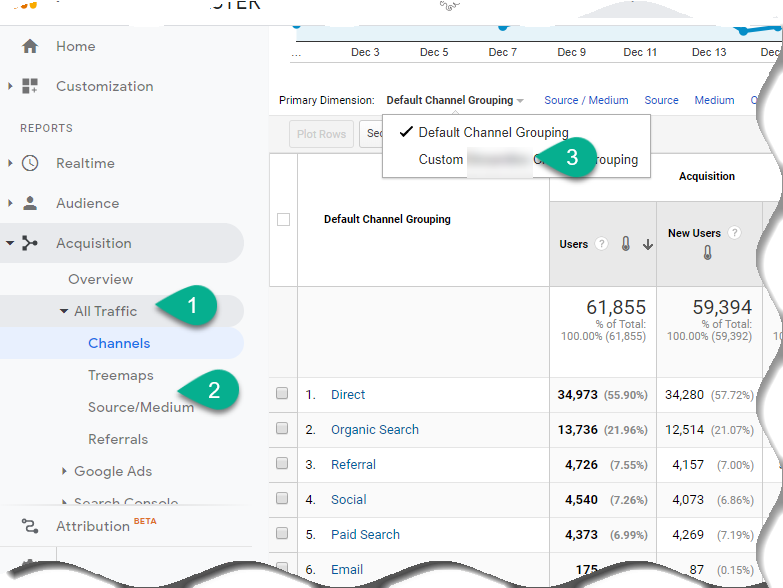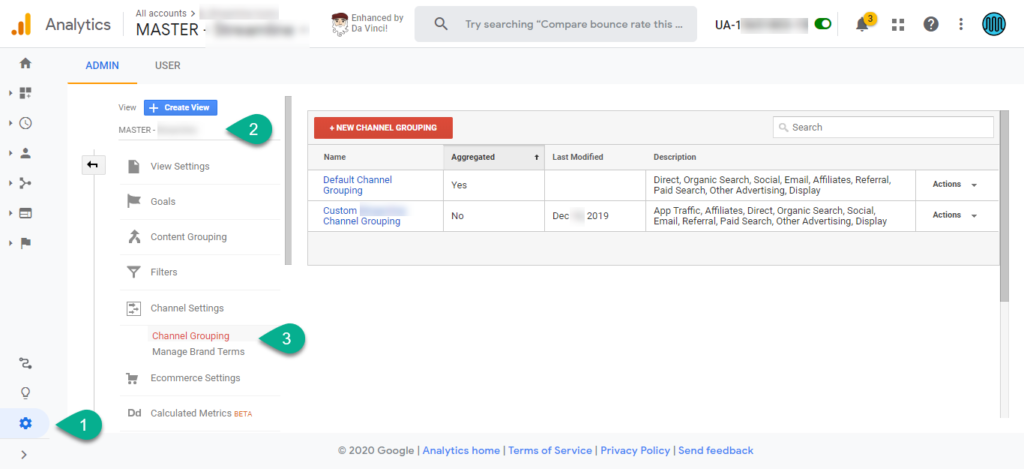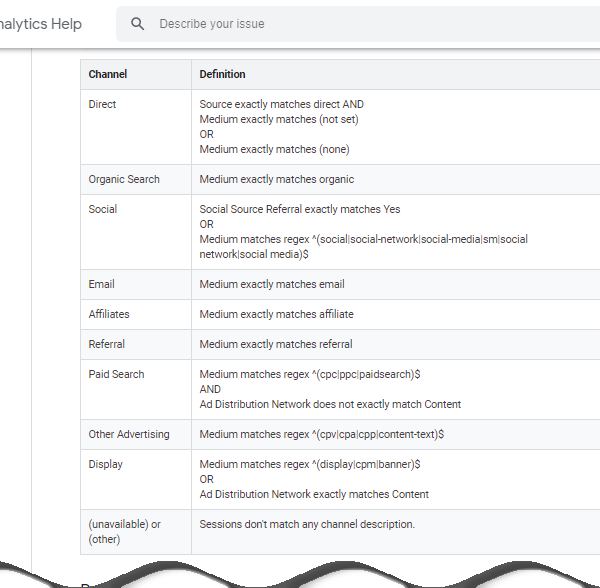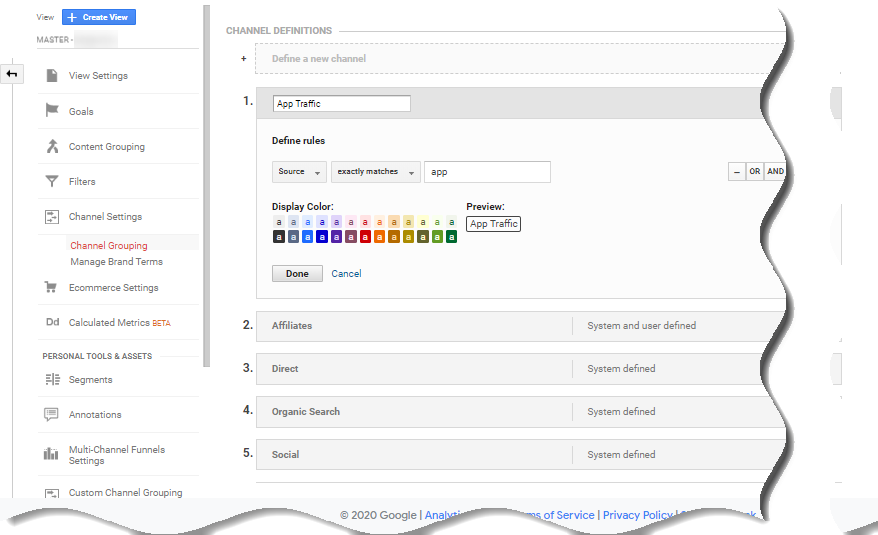
“Why “groups” of channels and not just use my source / medium reports?”

“Why “groups” of channels and not just use my source / medium reports?”

The standard Google Analytics channels are:
– Social: traffic coming from social networks (Twitter, Facebook, Instagram…);
– Direct: when the user types his URL directly in the address bar;
– Organic search: determined by organic means (unpaid), such as search results, for example;
– Paid search: traffic coming from Adwords search network campaigns;
– Display: people who accessed the site through the Google display network;
– E-mail: traffic through links sent by e-mail or determined by e-mail;
– Affiliates: through affiliate website;
– Reference: traffic where users clicked on a link from another website;
– Other advertising: people coming from online advertising outside of search and display

Baseline your Google Analytics Configuration with our 40-point Audit!
While these channels may appear to be straightforward categories, Google Analytics groups traffic for a channel based on the source and / or the medium (amongst other dimensions). This means that the quality of the data depends on the good work we do in using UTM’s and other tracking techniques.
For example, traffic can end up being poorly categorized when non-standard tags are used. If you use a non-standard medium for paid search (such as “payperclick” or “paid”), the resulting Sessions will not end in the standard container for the paid search channel. SImilarily, if you are simply using “cpc” within your Facebook Ads, chances are that data is coming into the “Paid Search” Cateogory.
Channel Groups are EXTREMELY important in the aim to make analytics easier for the business teams to find what they are looking for. While a clean and efficient UTM strategy is the ultimate goal, making definitions uncomplicated this is not always reality, especially when dealing with historical data.
—–DETAIL about how Social Media can be spread across several domains, is not always current, etc. and why we have an expaned list.
If you work with content for Social Media your sapecial channel should be SOCIAL.
This data is generated from advertisements or posts on social media. That is, all traffic coming from Facebook, LinkedIn Instagram (whether they are paid or not) are aggregated in this data. When someone finds your site via a link on social networks, they will be listed as social media on the traffic source. In the case of lesser-known networks, these traffic sources will probably not appear in the Social Media report, but in the Referrals report.
By looking at social networks as an acquisition channel, we can know which social networks are generating the best results within our project and, with the help of the metrics of the social networks themselves, we can understand when it is necessary to invest in ads or not. Just be aware and, of course, cross all possible data sources.
In addition to the standard, Google Analytics also offers the option to customize your channels. Personalization is interesting in the case of a specific objective, such as a campaign, for example. Thus, it is possible to measure traffic only from the source you have determined. Having this data in hand, adapting your strategy is much easier.
One of the many steps we take to ease the reporting time is create Channel Groups in many ways:
1) As Custom Groups in Google Analytics for quick and highly efficient real-time testing and variations
2) As Custom CASE Dimensions within Data Studio in order to provide historical analysis outside GA
3) As a Default Channel Group once everything is cleaned up
This an Exemple how you can build a CASA Dimension for your business:
CASE
WHEN REGEXP_MATCH (Source, ‘freewayseguros.com|insureone.com|txlowcost.com’) THEN ‘Owned Brands’
WHEN Default Channel Grouping = ‘Affiliates’ OR REGEXP_MATCH (Source, ‘valuepenguin.com’) THEN ‘Affiliates’
WHEN REGEXP_MATCH (Source, ‘fb|instagram’) AND REGEXP_MATCH(Medium, ‘sm|cpc’) THEN ‘Paid Social’
WHEN REGEXP_MATCH (Source, ‘yl’) AND REGEXP_MATCH(Medium, ‘onlinedirectory’) THEN ‘Online Directory’
WHEN Default Channel Grouping = ‘Paid Search’ AND REGEXP_MATCH(Query Match Type, ‘Generic’) THEN ‘Generic Paid Search’
WHEN Default Channel Grouping = ‘Paid Search’ AND REGEXP_MATCH(Query Match Type, ‘Brand’) THEN ‘Branded Paid Search’
WHEN REGEXP_MATCH (Source, ‘GO$|gemini|go$’) AND REGEXP_MATCH(Medium, ‘CPC|cpc|native’) THEN ‘Native Ads’
WHEN REGEXP_MATCH (Medium, ‘cpc’) THEN ‘Other Paid Search’
WHEN Default Channel Grouping = ‘Organic Search’ AND NOT REGEXP_MATCH(Source, ‘google’) THEN ‘Non-Google Organic Search’
WHEN Default Channel Grouping = ‘Organic Search’ AND REGEXP_MATCH(Source, ‘google’) THEN ‘Google Organic Search’
WHEN Default Channel Grouping = ‘Social’ OR REGEXP_MATCH(Campaign, ‘meetedgar’) THEN ‘Social’
WHEN Default Channel Grouping = ‘Email’ THEN ‘Email’
WHEN Default Channel Grouping = ‘Referral’ THEN ‘Referral’
WHEN Default Channel Grouping = ‘Other Advertising’ THEN ‘Other Advertising’
WHEN Default Channel Grouping = ‘Display’ THEN ‘Display’
WHEN Default Channel Grouping = ‘Direct’ THEN ‘Direct’
ELSE ‘Direct’
END
A very good way to start is to know the original CASE dimension from Google. See below:
CASE
WHEN ((Source=”direct” AND Medium=”(not set)”) OR Medium=”(none)”) THEN “Direct”
WHEN Medium=”organic” THEN “Organic Search”
WHEN (Social Source Referral=”Yes” OR REGEXP_MATCH(Medium,”^(social|social-network|social-media|sm|social network|social media)$”)) THEN “Social”
WHEN Medium=”email” THEN “Email”
WHEN Medium=”affiliate” THEN “Affiliates”
WHEN Medium=”referral” THEN “Referral”
WHEN (REGEXP_MATCH(Medium,”^(cpc|ppc|paidsearch)$”) AND Ad Distribution Network!=”Content”) THEN “Paid Search”
WHEN REGEXP_MATCH(Medium,” ^(cpv|cpa|cpp|content-text)$”) THEN “Other Advertising”
WHEN (REGEXP_MATCH(Medium,”^(display|cpm|banner)$”) OR Ad Distribution Network=”Content”) THEN “Display” ELSE “(Other)”
END
This process is both art and science:
ART: what are some of the best ways to split up marketing channels, how is the biz used to seeing it, where do we see the largest variations that should be split up … how should this be taken in effect with a UTM strategy.
SCIENCE: Coordinating all the various landing pages, source, medium, campaigns, Creating the right regular expressions, Cross examining between GA and Custom Dims.
Things to have on mind:

1 Comment. Leave new
[…] of CASE Dimensions in order to group data for better comprehension while also allowing retroactive Custom Channel Groups and Content Groups to be […]